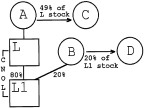By: David J. Herzig
The New York Times wrote about the Pratt Family burial plot. As Daniel Hemel pointed out there was also a tax story; apparently, the cemetery qualifies as a 501(c)(13) tax-exempt entity. So, when you combine tax and a Cleveland company, I was fascinated by the story. [1]
Because the cemetery is tax-exempt under section (c)(13), it can only benefit its members. This is contrary to the general rule for tax-exempts that you benefit everyone as opposed to just members. The question that the IRS had to address was how discriminatory could the cemetery be. For example, whether both the Rockefellers and the Pratts could be buried in the cemetery. According to Daniel’s review of the rulings and regulations, “the Pratt family cemetery won’t lose its tax exempt status if it excludes the Rockefellers (or any other non-Pratts) from being buried there. But the family cemetery need not limit membership to Pratts in order to maintain its tax exemption.” All of which is true.
But, I wondered why does the family care so much about maintaining the tax exemption. I started to dig around to find the 990s of the cemetery. What if the tax-exemption were terminated? (As a certain President Elect has come to decide – sometimes the maintenance of tax-exempt entities are more trouble than they are worth).
I think I found the correct entity (this was not disclosed in the article) – the Dosoris Cemetery Trust. As of December 2014, the entity had $163,384 in net revenue and $119,206 in net expenses generating $44,178 of net income. The majority of the net income came from the sale of assets. The entity has about $1,800,000 in assets and no liabilities. Not all years did the entity operate at a profit. For example, the year before, the entity had about a $19,000 loss.
The most interesting detail of the 990s is the minor contributions made to the entity. As you cascade through the 990s, it seems that there are minor contributions (about $25,000 a year) and the entity sells off assets to make payroll. [2]
If the tax-exemption were terminated what would happen to this corporation? There is actually a first question of who would own the corporation. My fellow blogger, Sam Brunson and I are working on a law review article about who owns a tax-exempt entity.
For the Pratt’s the most important differences would be, the loss of the tax subsidized contribution of operational capital and property tax exemption.
For example, the $25,000 a year contribution would not be tax-free income to the entity nor deductible under 170(c)(5) to the contributor. Now, this impact could be mitigated if either (1) the contribution was deemed to be a gift (no income no deduction) or (2) if the contributor received shares in the entity which might generate loss in the future.
Under New York law, it would seem that the entity would qualify as exempt from property taxes. Let’s assume the land valued at the depreciated value of $500,000 (I could not find the PVA assessment since I could not locate the actual address of the cemetery). It seems that this exemption would be rather meaningful at about $15,000 a year.
There would be other effects to the loss of tax-exempt status. However, the impact of the loss of status would most likely be offset by changes to the operation of the entity. For example, all the income from the sale of the securities to meet payroll would become taxable income to the entity. It would be reasonable to assume with the new taxable structure, the asset blend of the securities portfolio would be altered to take into account the income needs and the taxable status. Further, budgetary shortfalls may be made up by charging admission to the cemetery, selling plots to other family members or other for profit enterprises, which currently may be permitted, but, would be UBIT under the 501(c) rules.
Finally, the entity would also most likely structure the operational side of business to create additional expenses to offset income. For example, maybe hiring more employees or officers taking salaries.
As it turns out, there is little impact to the Pratts’ for the loss of tax-exempt status. To the extent there is taxability, the effects can be mitigated or eliminated by changing the behavior of the entity. Without the distortion of tax-exemption, the entity will behave like other entities.
Perhaps the more troublesome part of the story is the idea that there is a tax subsidy (via the 170 deduction) for the Pratts to continue to operate a cemetery for their family’s exclusive use. I am not sure of the benefit to society of having private family cemetery plots that are tax-exempt. This seems qualitatively worse than say owning a private foundation that purchases Tim Tebow helmets and self-portraits. Yet, it is expressly permitted under (c)(13). Any thoughts on a current justification?
[1] Having grown up in Cleveland, the Standard Oil connection resonated with me. For those that don’t know, Standard Oil was founded in Cleveland in 1870. So much of Cleveland, including the vibrant art, museum and music community, depended on the early generosity of John D. Rockefeller.
[2] Although the investment advisor did have a good year recently growing the fund from $900,000 to $1,100,000 in a year (nice 22% growth).
